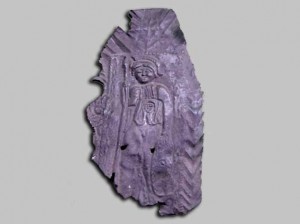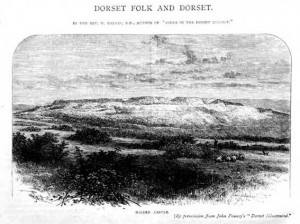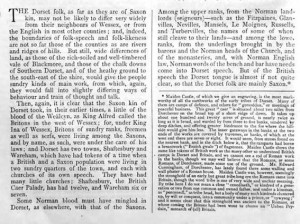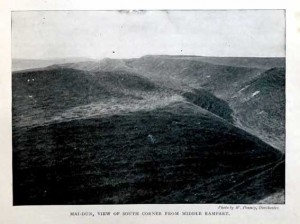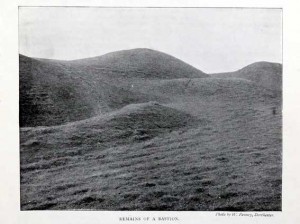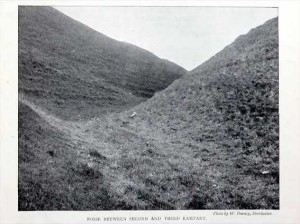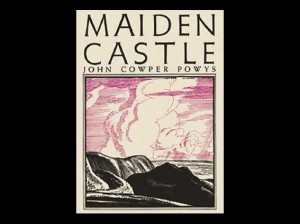Maiden Castle
Jim Potts
Writing about South Dorset, Dorchester and Maiden Castle, Martin Papworth in his book 'The Search for the Durotriges, Dorset and the West Country in the Late Iron Age', The History Press, 2011 states:
"This study area contains some of the most exciting archaeological landscapes in the country'
The frustrating thing about archaeology is the lack of certainty. Studying the reports of Maiden Castle excavations over the years, one can't be sure that the '˜Romano-Celtic Temple' was a temple at all, that the '˜war' cemetery was a war cemetery, that the Romans actually attacked the hill-fort or that there was a bloody battle.
If the Romano-British temple was in fact a temple, was it dedicated to Minerva, to Diana or a pagan cult deity? Did Ptolemy's Dunium (Dounion) refer to Maiden Castle or to Hod Hill? The ancient pebble sling-shots unearthed by Mortimer Wheeler were later supplemented by the archaeologist, it has been alleged, with pebbles from Chesil Beach, to be sold as souvenirs in a modest scam, to raise money for the dig.
From an article on Sir Mortimer Wheeler, Archive gives up secrets of the first monuments man by Oliver Moody, The Times, April 26, 2014:
"Money was short, and the archives reveal that he resorted to several 'scams' to raise funds. While the couple were working on Maiden Castle, the Iron Age hill fort in Dorset, Dr (Gabriel) Moshenska said that Sir Mortimer sold hundreds of 'slightly forged' ancient slingshots taken from nearby Chesil Beach".
"When money was tight Sir Mortimer resorted to selling 'slightly forged' ancient slingshots taken from Chesil Beach to raise much-needed cash, along with several other 'scams', according to archives of his work'.
It interested me to read of Public Archaeology as performance and public relations, of the opening of sites to sell inexpensive souvenirs to visitors, to help fund the digs;
I remember well Lesley Alcock's excavations of Cadbury Castle, and all the talk of King Arthur.
There must be a great temptation to think, or to suggest, that a theory or an attractive idea will eventually prove to be largely correct, even if the finds and the evidence are ambiguous or inconclusive.
It's hardly surprising that some writers, when popularising the period and the location, tend to simplify and romanticise uncertain events. In the absence of archaeological certainties and as a result of changing theories, why can't we focus on specific finds and clues and chose to believe whatever we want to believe? Much remains open to interpretation.
I want to believe that the Maiden Castle temple was a small temple dedicated to Minerva (Athena), that Dunium was Maiden Castle and not Hod Hill, for instance. Thomas Hardy wrote of the hill fort as " '˜Mai'"Dun,' '˜The Castle of the Great Hill,' said to be the Dunium of Ptolemy, the capital of the Durotriges'.
Steven Rayson's novel of Maiden Castle, "The Crows of War' (1974) contains some very exciting descriptions of the assault on Maiden Castle by the IInd August legion under Vespasian. The reader can visualise the assault as vividly as could be achieved in any Hollywood film epic. But this is a work of fiction and much invention, of a rich imagination building on elements of previous archaeological and historical research. As the author states in his Addendum, "This story is a fictionalised fragment of the Roman invasion of Britain'. He also writes about the temple: "the present temple is Romano-British, and of late date. Inside was found a votive statuette of a triple-headed goddess astride a bull. Though both are later than the first century, I have suggested that they enshrine the memory of an earlier temple and goddess'.
Before the assault:
"Though Vespasian was supremely confident, many who stared up at the frowning embankments were shaken. Were they really expected to assault such a place? Could Mai-dun be subdued, was it humanly possible? The fort glowered down insolently, daring them to try. Every strongpoint that had fallen to the legion thus far seemed puny in comparison, and the colossal entrenchments gloated over their discomfiture (p.142-143).
Another, more recent, novel of the Roman '˜assault' on Maiden Castle is "Defenders of Mai-dun' by David Macpherson (2010). If it is a less exciting read than the Steven Rayson novel, it may be a more suitable introduction to the events for the younger reader, and more accurate in some respects. Macpherson provides some facts behind the story: "The great archaeologist Sir Mortimer Wheeler, who excavated Maiden Castle in the 1930s, wrote a breathtaking account of the bloody Roman assault, but Niall Sharples' dig in 1985 found little evidence to support this idea. As there are no sign of destruction of the hillfort, it would suggest the inhabitants surrendered peacefully'. Macpherson created all his Roman characters, apart from Vespasian, Titus and Publius Maximus, and he created all the Durotriges characters.
Both authors draw freely on their imaginations, and make plausible suggestions where certainty is lacking.
It seems that Leslie Alcock, in the course of his highly publicised excavations at Cadbury Castle, South Cadbury, wanted to believe (or the Camelot Research Committee, President Sir Mortimer Wheeler, wanted the public to believe) that this was probably the site of the legendary King Arthur's Camelot (see Cadbury: is it Camelot?, by Leslie Alcock and Geoffrey Ashe, "The Quest for Arthur's Britain', ed. Geoffrey Ashe, The Pall Mall Press, 1968.
"Was the Committee justified in appealing for funds to a broader public, whose interests would be almost purely Arthurian?...There could be no objection to seeking further funds for a '˜Quest for Camelot' (as the operation was soon called)'.
"Cadbury Castle, appropriately for Camelot, was plainly a kind of British Troy'.
For visitors and journalists and the '˜more literary-minded supporters of the Camelot Research Committee', "the project would stand or fall by its success in upholding Cadbury's claim to be Camelot.' Soon, "it could now be said that a person of importance '" an Arthur-type figure, so to speak- had lived in the hill-fort at approximately the right time'¦.its claim to be Arthur's fortress was now much strengthened'¦The conclusion is inescapable that it was the fortress of a great military leader, a man in a unique position, with special responsibilities and an unusual temper of mind'¦The lord of Cadbury was a person as much like Arthur as makes no matter'¦Nowhere else but at Cadbury does Britain supply any archaeological trace of such a person'..
"Alcock's sense of humour also came out during the excavations. He had a good understanding of what visitors to the site wanted to see, so he had a plastic skeleton excavated from the same spot every afternoon, with a bucket beside the trench to take donations for the diggers' welfare fund. The money was used to the benefit of the local economy each evening in the pub' (Wikipedia)..
Some Perceptions of Maiden Castle
Wo ist das Schloss?
Walking on Maiden Castle one evening, I was approached by two disappointed and confused German hikers (mother and daughter). They'd walked from Abbotsbury, and they were tired after having lost their way near the Hardy Monument, "Where is the Castle? Where is the building?"
Wo ist das Schloss, indeed. They showed me their map. They'd been told they mustn't miss it on any account. They'd expected an imposing stone building, or something like the ruins of Corfe Castle.
I wish I had remembered what William Barnes once wrote, in a letter of August 17th, 1865:
"Castellum...meant an earthwork till stone castella were built in far later times". Barnes derived Maiden from the Celtic 'Mai dun', "the stronghold by the plain or with a plain top."
Sir Mortimer Wheeler (1943) argues that the derivation of the name is uncertain: "no attempt to derive it from the Celtic or other originals is of substantive value".
Visitors to Maiden Castle can now make use of the intriguing Echoscape audio app. With its good use of quotations, sound FX and music to stimulate the imagination and evoke the deus loci of the place.
"Walk towards me, and let's see whose imaginations you come across' - the narrator is a female voice, Maiden Castle personified; other characters are Nonna, the Iron Age story-teller; Thomas Hardy, Paul Nash (WWI, The Great War),Vespasian and Mortimer Wheeler (Wheeler is described): '˜he says "It's a war grave''; "Wheeler is puffed up and proud, with big moustaches on his sun burnt face. He's excited, like a child, waving me over to something he's found in a far pit'.
The effect may seem a bit over-the-top, the voices of the actors sounding rather too theatrically histrionic at times, at least for my taste, but perhaps ideal for a seven-to-ten-year-old listener used to the traditional BBC School Radio speaking style.
"Echoscape is an immersive audio experience that connects time, place and imagination. Maiden Castle has been a focus of imagination for countless people over its history. In this audio experience visitors can listen to the viewpoints of modernist painter Paul Nash, writer Thomas Hardy and Iron Age storyteller Nonna. By exploring their stories within this ancient landscape, Echoscape asks us to consider our own place within Maiden Castle's ongoing history'. "The audio experience is 40 minutes long and is suitable for ages 7+. There is no set route to follow but the visitor is encouraged to explore the ancient earthwork as they listen. The piece uses 3D sound and requires headphones' - Echoscape is a Splash & Ripple production for English Heritage.
"Follow your feet. Keep heading upwards, there is more of me to discover'.
"I am a focus of imagination. Many people have stood here, where you are right now, looking, listening, feeling the breeze on their faces. Wondering who came before and who will come next. You are one of them'.
This audio experience is a Splash & Ripple production for English Heritage. It was written by Rosie Poebright, using some of the writings of Paul Nash and extracts from Thomas Hardy's short story, "Tryst at an ancient monument'. Nonna's Iron Age story was informed by Wheeler's excavations and the writings of Tacitus. Sound design and music was created by Helen Skiera using the vocal talents of Alice Barclay, Andrew Collins, Ian Harris and Stevie Thomp.
"Time is like this place: enfolding circles like my ramparts and layered like the soils and sediments under your feet. Let your imagination bore through those layers of time so you can feel the stories of those others all at once'.
English Heritage: Echoscape: An Audio Experience
Perhaps, rather than worrying about conflicting theories, those of us who are not archaeologists (and sometimes those professionals too) should give more emphasis to our experiences of the landscape, and the records (literary, artistic, photographic or musical) of other people's experiences over time. Professor Timothy Darvill emphasises the experience of being amongst ancient monumental environments and '˜persistent places', places which have and held deep meaning for people, to which they keep coming back. That is where a painter like Paul Nash provides insights and powerful responses to the strange pull and experience of a site and its inscape.
More perceptions of Maiden Castle:
Arthur Mee:
"Here are 100 acres as thrilling as any piece of English earth, the home of thousands of people thousands of years ago, with a story unfolding itself in dramatic chapters which must move the mind of an Englishman with a sense of mystery almost too deep for words'.
Frederick Treves:
"Maiden Castle '" the Mai-Dun or Hill of Strength'¦remains to this day the most stupendous British earth-work in existence'.
Richard Ollard:
"Its effect is proportionate to the solitude of the observer'.
Geoffrey Clark and W. Harding Thompson:
"It is hard to believe that early man with his primitive tools could achieve such masterpieces of engineering, and the stupendous efforts which he made become overwhelming in their impression when we stand in the fosse at Maiden Castle and gaze at the bank of earth which rises so steeply above our heads'
Thomas Hardy:
"Acoustic perceptions multiply to-night. We can almost hear the stream of years that have borne these deeds away from us. Strange articulations seem to float on the air from that point, the gateway, where the animation in past times must frequently have concentrated itself at hours of coming and going, and general excitement. There arises an ineradicable fancy that they are human voices; if so, they must be the lingering air-borne vibrations of conversations uttered at least fifteen hundred years ago.'
Thomas Hardy, A Tryst at an Ancient Earthwork; A Changed Man (A version of this story was published as 'Ancient Earthworks at Casterbridge' in the English Illustrated Magazine, December 1893, pp. 281-8, with four photographs of Mai-Dun by William Pouncy of Dorchester.)
"At one's every step forward it rises higher against the south sky, with an obtrusive personality that compels the senses to regard it and consider. The eyes may bend in another direction, but never without the consciousness of its heavy, high-shouldered presence at its point of vantage. Across the intervening levels the gale races in a straight line from the fort, as if breathed out of it hitherward. With the shifting of the clouds the faces of the steeps vary in colour and in shade, broad lights appearing where mist and vagueness had prevailed, dissolving in their turn into melancholy gray, which spreads over and eclipses the luminous bluffs. In this so-thought immutable spectacle all is change.
Out of the invisible marine region on the other side birds soar suddenly into the air, and hang over the summits of the heights with the indifference of long familiarity. Their forms are white against the tawny concave of cloud, and the curves they exhibit in their floating signify that they are sea-gulls which have journeyed inland from expected stress of weather. As the birds rise behind the fort, so do the clouds rise behind the birds, almost as it seems, stroking with their bagging bosoms the uppermost flyers.
The profile of the whole stupendous ruin, as seen at a distance of a mile eastward, is cleanly cut as that of a marble inlay. It is varied with protuberances, which from hereabouts have the animal aspect of warts, wens, knuckles, and hips. It may indeed be likened to an enormous many-limbed organism of an antediluvian time '” partaking of the cephalopod in shape '” lying lifeless, and covered with a thin green cloth, which hides its substance, while revealing its contour. This dull green mantle of herbage stretches down towards the levels, where the ploughs have essayed for centuries to creep up near and yet nearer to the base of the castle, but have always stopped short before reaching it. The furrows of these environing attempts show themselves distinctly, bending to the incline as they trench upon it; mounting in steeper curves, till the steepness baffles them, and their parallel threads show like the striae of waves pausing on the curl. The peculiar place of which these are some of the features is '˜Mai'"Dun,' '˜The Castle of the Great Hill,' said to be the Dunium of Ptolemy, the capital of the Durotriges, which eventually came into Roman occupation, and was finally deserted on their withdrawal from the island".
John Cowper Powys:
"It is hard to believe that objects of frantic invocation, however weird and monstrous, do not release, when freed from their long imprisonment, something of the magnetic potency that the minds of their far-off worshippers communicated to them as they prayed'.
M. R. Skilling:
"The magnitude of the original ramparts may be appreciated when it is realised that some two thousand years of erosion have taken place'.
Christopher Priest:
"The Castle was ancient and solid, and permanent; its grass-covered shoulders had shrugged off decay for five thousand years and it would still be here in five thousand years' time."
A Dream of Wessex by Christopher Priest, 1977
John Kenyon:
"Along thy sides they stretch, ring above ring,
Marking thee from afar; then vanish round
Like the broad shingly banks, which ocean heaves
In noble curves along his winding shore.
The passing wayfarer with wonder views
E'en at imperfect distance, their bold lines,
And asks the Who? the Wherefore? and the When?
Wafting his spirit back into far times,
And dreaming as he goes. But whoso stays,
And climbs the turf-way to thy tabled top,
Shall reap a fuller wonder; shall behold
Thy girdled area, of itself a plain,
Where widely feeds the scattered flock; shall mark
Thy trenches, complicate' with warlike art,
And deep almost as natural ravine
Cut in the mountain'¦'
1836 (published 1838)
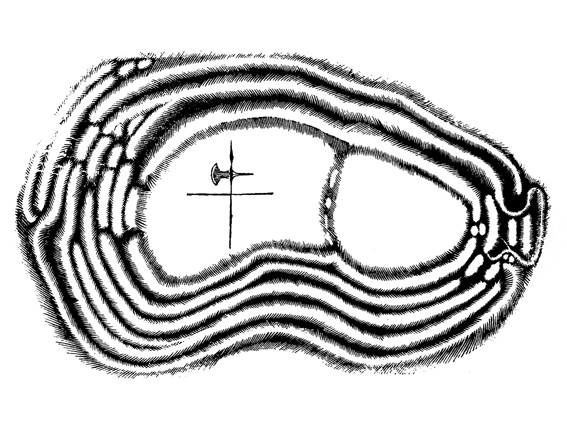
William Barnes:
A British Earthwork (An Archaeologist Speaks),
(First Stanza)
The grassy downs of Dorset,
Rising o'er our homes of peace,
E'er teem with life and riches
In the sheep and precious fleece;
And charm the thoughtful roamer
When, like us, he climbs to scan
Their high-cast mounds of war '" the works
Of Britain's early man,
Whose speech, although here lingers yet
His mighty works of hand,
Has ceased a thousand years to sound
In air of this green land,
And startled may it be to hear
The words of British kin '”
An gwaliow war an meneth
An caer war an bryn...
("The ramparts on the mountain, the stronghold on the hill')
The morning at Maiden Castle was a fatiguing one to many, as the carriages had to be kept at the foot of the earthworks, while the Poet led the members over the "vallum " and mound, and up the steep walls of turf at a rate more in accordance with his own eagerness than the strength of their lungs. One very enthusiastic lady was determined not to lose a word of wisdom from the mouth of the guide for the day, and she literally hung on to the skirts of his cassock as he clambered up the
sides of the hills. Arrived at the top a vigorous discussion took place, Barnes holding Maiden Castle as a British work, and the argumentative and another member declaring that it was Roman. Barnes fled as usual to philology for help. " It's very name is Celtic ' he said. Mai dun, the stronghold by the plain, or with a plain top' Here he glanced round on the wide expanse of green turf which formed the summit of the earthwork. The Rev. H. Moule confirmed this by quoting an Irish friend's derivation of it from the Irish Magh dun, which meant the same thing.
The life of William Barnes, poet and philologist by Scott, Leader,
Rev. William Miles Barnes:
Maiden Castle, as you have seen, is a stupendous earthwork, the finest example of a British caer to be found in England. Professor Scarth, in "Roman Britain," wrote thus of it : "Antiquaries are generally agreed that the most elaborate and most strongly fortified earthworks are generally the most ancient. These appear to have formed the central positions of tribes, who resorted thither in times of danger, where they could defend themselves with advantage. One of the most perfect and most elaborately fortified may be seen near Dorchester; it is called 'Maiden Castle."
In form the earthwork is an irregular oval, enclosing an area of about 45 acres. The extreme length of the enclosure is stated to be 2,500 feet, its greatest width 900, the ramparts from the floor of the ditch are 60 to 90 feet in height. Around the enclosure is a breastwork of earth. Its highest plain is 265 feet above the sea level. The ramparts and ditches of the eastern part are treble on one side, double on the other, though at the entrance they are increased, there being five on one side of the entrance and six on the other. Here the ramparts overlap each other, making the entrance a maze very winding and intricate.
This eastern part of the work is the oldest. The evidence is before you '” you will observe that the whole area is divided by this breast-work which, as you will see from the curve of the ramparts, was once the boundary of the earthwork on this side ; to enlarge it the Britons filled in the ditches and levelled the ramparts on this side and dug out and threw up four lines of ramparts round the addition instead of three as in the old work. Clear traces of an occupation subsequent to the British have been discovered by our friend Mr. Cunnington, who, in his excavations here, has found Roman remains and the foundations of Roman or Romano-British buildings. As these discoveries may help to revive old Hutchins' belief that Maiden Castle was a Roman earthwork, and in the earlier days of the Roman occupation the Roman Durnovaria, it may be as well to show why that is exceedingly improbable.
Proceedings of the Dorset Natural History and Archaeological Society Vol. 14, 1893
Paul Nash:
Maiden Castle "struck awe even into the most vulgar mind', 1936.
Genius loci:
"Nash opened up the grand narrative of history and brought past, present and future together. This is antithetical to the archaeologist's empirically established timeline, which constructs a clear-cut chronology'. Sarah Fill, Paul Nash, Surrealism and Prehistoric Dorset, Paul Nash, Tate Publishing, 2016
"Browne and Stukeley used the past as a means to muse, in the terms of religion and mythology, upon the present. In turn they revitalised antiquity by investing it with their own imaginations.
I argue that Nash revitalised the past in a manner akin to Browne and Stukeley, although he did not do this with the religious spirit of the early modern period but reconstructed it through the building blocks of continental modernism. I argue that Nash's engagement with antiquarianism helped form a critique of the archaeological practice he witnessed at Avebury and Maiden Castle in the mid 1930s. While the science-orientated discipline of archaeology participated in the death of myth, Browne and Stukeley formed part of mythology's long narrative tradition. I examine how Nash's landscapes also formed part of this tradition and I consider the paintings' relationships to the mythic aspects of interwar modernism'. Sarah Fill, unpublished doctoral thesis, from abstract '" Sarah Fill, Unearthing Modernism in the Strata of Antiquity : Paul Nash and the Deep Past. 2015. 308 p. "they revitalised antiquity by investing it with their own imaginations'.
"Dorset presented a '¦treatment of the past by envisaging the county's ancient earthworks through a surrealist lens that thoroughly opposed contemporary, science-based, archaeological practice.' (Paul Nash, Tate).
John Ireland: Mai-Dun, Symphonic Rhapsody
"Ireland's Mai-Dun was composed in 1920-21, some 15 years before Sir Mortimer Wheeler excavated the site of this prehistoric fortified township', Christopher Palmer, CD booklet, Chandos.
"Symphonic Rhapsody: Mai-Dun (1921). In Mai-Dun Ireland uses Thomas Hardy's name for the prehistoric fort and earthworks at Maiden Castle near Dorchester. It is a strong piece, aggressive at times, resourcefully scored, and Ireland's imagination was ignited by the largest hill-fort in England, dating from 3000BC, and its violent history'. Gramophone Release Date: May 1986, originally recorded in 1985
Related Sources:
- Excavation of Maiden Castle, Dorset: first interim report by Sir Mortimer Wheeler, 1935
- Department of Environment Official Handbook: Maiden Castle, Dorset by Sir Mortimer Wheeler, 1972
- Mortimer Wheeler's Theatre of the Past Gabriel Moshenska & Tim Schadla-Hall Journal of Public Archaeology, Vol. 10, 2011, No. 1, Pages 46-55 | Published online: 19 Jul 2013
- Royal Holloway, University of London: Unearthing Modernism in the Strata of Antiquity : Paul Nash and the Deep Past. Sarah Fill
- English Heritage: Maiden Castle
- Dorset County Museum




